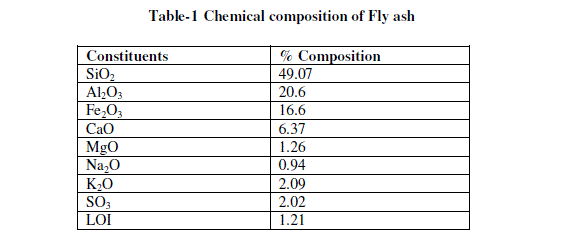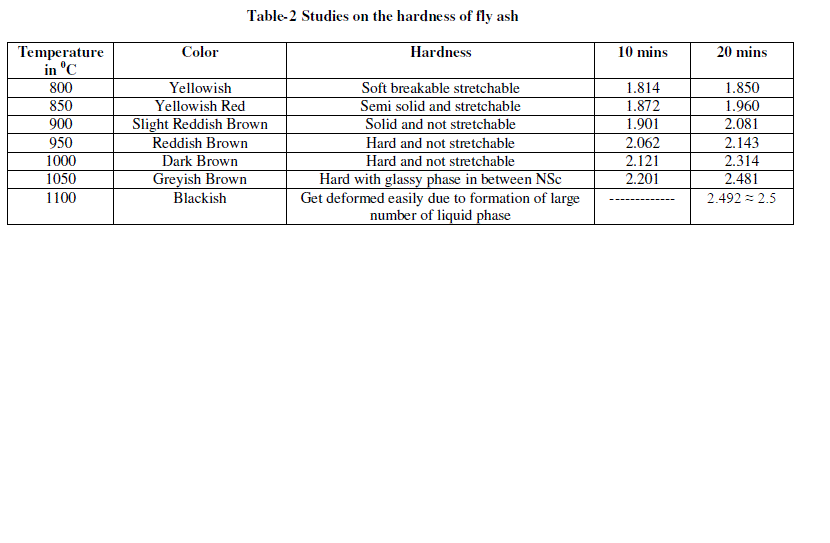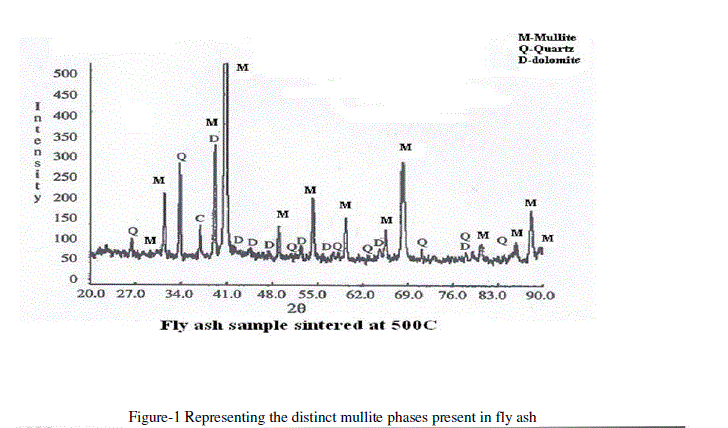ISSN ONLINE(2319-8753)PRINT(2347-6710)
ISSN ONLINE(2319-8753)PRINT(2347-6710)
B.B. Kar1., S.Dash2, S.M.Mustakim3and T.K.Panda4
|
| Related article at Pubmed, Scholar Google |
Visit for more related articles at International Journal of Innovative Research in Science, Engineering and Technology
The present study includes the microwave sintering of a class F fly ash available in the nearby power plant. The ash sample was subjected to sintering with addition of an admixture which is a cheap industrial waste along with water. The sintering temperature was varied in the range of 7000C to 10500C. The sintered mass has diametrical tensile strength up to 30 MPa (corresponding diametrical compressive strength will increase 90 MPa) and the densities also increases up to 2.5 r/cm2 g/cm2 when sintered for 25-35 mins. It has been observed that the samples obtained through microwave sintering is denser as compared to the general sintering processes like draft sintering or pan sintering etc. the sintered pellet obtained after microwave treatment are found to be stronger with high tensile strength. The entire study revealed that microwave sintering of Class F flyash could produce a glossier ceramic phase where mullite (Al2Si2O13) and Anorphite are found to be the prominent crystalline phases.
Keywords |
| Flyash, microwave, sintering, glassy phase. |
INTRODUCTION |
| Burning of anthracite and bituminous coal are the base for the release of Class F flyash. The classification as Class F is due to more iron content of the flyash. The generation of flyash in India is very high because of the presence of power plant in which coal is used as the energy source. India generates about million that tons of flyash a normally out of which only 20% is subjected to utilization and rest get dumped as a waste material. Proper utilization of this challenging waste with an environmental friendly technology is a major concern for scientists and researchers(1-6). With the instant cooking ability microwave energy has been proved to be an efficient technique to treat most of the ores and minerals. The microwave energy has the advantage over the conventional energy in which the microwave energy enters into the material initially followed by rise in insitu temperature, where heat get generated from the material and spread through the surrounding atmosphere. The interaction between the microwave energy and the flyash produce a volumetric surface area that leads to a more efficient sintering process(7-11). Due to this in depth interaction, microwave process is less time consuming with higher heating efficiency to provide a uniform heating environment. The complex oxidic composition of flyash with an amorphous texture makes it more reactive with reference to microwave roasting. Some preliminary attempt has been made to understand the penetration efficiency of microwave energy into the glassy ceramics(12-18).Encouraging results have been achieved by the researchers in this aspect and keeping in view the above observation, in the present study an attempt has been made to understand the role of microwave technique to produce a better sinter product when flyash is subject to study. In this process, no binder has been used during pelletization except water. |
EXPERIMENTAL |
| A class F flyash sample is used as the study material, whose chemical composition has been represented in Table-1. During pelletization, quality water is added to the flyash samples were uni-axially pressed at 40 MPa to produce circular pellets of 10mm diameter with a reasonable green strength. In the entire process water addition helps during penetration of microwave energy into the flyash sample as well as to improve the microwave absorption capacity of the pellet. |
 |
Equipment Modifications |
| The microwave under consideration has capacity at 3.GHz which has been prepared from a commercial microwave of 900W (LG made) which has a movable base. Sintering was carried out in 20numbers batch. During the microwave sintering the movable table rotates in such a systematic fashion that all the pellets could be provided uniform sintering atmosphere. The temperature of the insitu materials were measured using Pt-Pt-Rh thermocouple, inserted from the top of the microwave. Under such a temperature and sintering atmosphere, microwave sintering of the pelleted flyash sample has been carried out. |
RESULT AND DISCUSSION |
| Experiments were carried out with 20 numbers of pellets in each run with 10mm diameter which has been sintered in a temperature range of 8000C to 11000C. The time span per sintering was kept constant i.e. 20 minutes time per run. Using weighing and dimensional measurements, the density of the sintered pellets have been measured. Similarly, using a Universal testing machine, the diametrical tensile strength has been calculated with a loading rate of 0.4 mm/min. the changes in the structural morphology is measured using scanning Electron Microscope. The formation and evaluation of various glassy phases and the entire phase change has been analyzed using XRD. The entire study revealed that the pellets processed at 8000C are found to be slightly soft with yellowish color, which can be scratched easily. Under this condition, the samples are assured to be partially sintered. With the rise in temperature the change in color and density has been represented in Table-2.Density of the sintered flyash at different microwave sintering period. |
 |
| The density of the sintered pellets processed in the temperature range of 8000C to 11000C for 10 to 20 minutes could be achieved in the range of 1.695 to 2.502 g/cm3. With the rise in temperature and time there is gradual increase in the sinter density till 10500C. With further rise in temperature there is formation of glassy liquid phase that leads to decrease the density of the sintered pellets with deformation of the textural structure. At around 9500C to 10500C the green density is low which is attributed to the formation of hollow glassy particulate structures in the larger surface of flyash. The data revealed that the microwave energy could constantly produce higher density which may be attributed to the fact that microwaves catalyses the perfect diffusion of the phases present in flyash to make the phases denser. In addition to the above, the time requires for sintering is found to be very less when taken into consider for the other conventional sintering processes, i.e. from 1hr to 30 hrs time. Taking into consideration the tensile strength, it has been seen that the flyash sample when subjected to sintering at 8000C has the diametrical tensile strength of 4 MPa (as reported in Table-3). |
 |
| With rise in temperature from 8000C to 10500C, there is a constant rise in the tensile strength. It has also observed that at a lower temperature at around 9500C there is rise in tensile strength upto 74% from the initial one which is almost equivalent to the microwave sintered sample prepared at 11000C heated for 10 minutes. As the compressive strength is three times of that of the tensile strength, the microwave sintered flyash pellets can be considered as the strong light weight material. The X-ray diffraction study represented in Fig-1 revealed that a distinct mullet phase with a fusible crystalline phase is getting generated when the sinters are subjected to microwave sintering. With the rise in temperature till 10500C, there was no other prominent phase, except mullite with negligible peaks of anorthite. However, the intensity of the mullite phase broaden slightly at 400C 2θ (200) range. When the sample was treated at 11000C for 20minutes, distinct anorthite phase appeared with a broaden band structures representing the glassy phase formation at higher temperature with micro fractures as represented in Fig-2. |
 |
CONCLUSION |
| The study revealed that an appreciably strong flyash sintered material can be prepared preferably by adopting microwave sintering technique. The process is proved to be less time consuming and more productive. The sample obtained after sintering is proved to be of high tensile strength, compressive strength with a more dense compact structure. |
References |
|